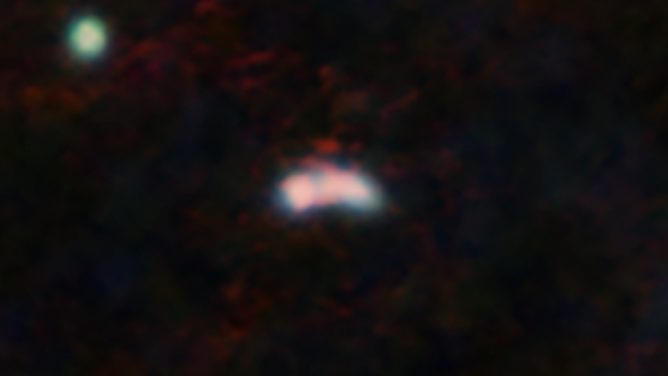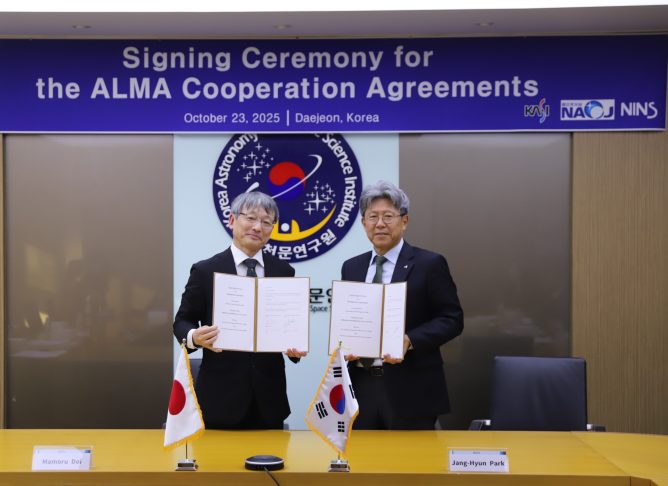2024.12.13
ALMA Reveals the Birthplace of a Planetary System: Dust Accumulation to form a New Planet outside Just-Formed Planets
To date, more than 5,000 planets have been identified both within and outside the Solar System. In some cases, they compose planetary systems consisting of multiple planets. These planets are believed to originate from micron-sized dust grains in the protoplanetary disks that surround young stars. However, how these dust grains accumulate locally and lead to the formation of planetary systems remains unknown.
PDS 70 is the only known celestial object with already–formed planets, confirmed by optical and infrared observations, within a protoplanetary disk (https://www.eso.org/public/news/eso1821/). Unveiling the distribution of dust grains in this object will provide insight into how the already formed planets interact with the surrounding protoplanetary disk and potentially influence subsequent planet formation.
Previous observations with ALMA at 0.87 mm revealed ring-shaped emissions from the dust grains outside the planetary orbits. However, the emission source might be optically thick (opaque, with dust grains on the near side obscuring those behind them), and the observed emissions distribution might not accurately reflect the distribution of the dust grains.
The researchers led by Kiyoaki Doi performed high-resolution observations of the protoplanetary disk around PDS 70 at a wavelength of 3 mm with ALMA. The observations at 3 mm are optically thinner (more transparent), providing the distribution of the dust grains more reliably. The new observations at 3 mm showed a different distribution from previous 0.87 mm observations and revealed that the dust emission is concentrated in a specific direction within the dust ring outside the planets. This suggests that dust grains, the building blocks of planets, accumulate in a narrow region and form a localized clump.

Composite images of PDS 70 in pseudo color. The left panel shows previous ALMA observations at 0.87 mm, and the right panel shows new ALMA observations at 3 mm. The composite image combines millimeter/submillimeter continuum images with ALMA (red), an infrared continuum image from W. M. Keck Observatory (green), and an optical image of a hydrogen emission line taken with the VLT (blue). The images show that the dust emissions observed with ALMA form a ring-like structure outside the planets detected by Keck and the VLT. At a wavelength of 3 mm, the dust emission can be seen prominently concentrated in the northwest direction (upper right of the image). Image Credit: ALMA (ESO/NAOJ/NRAO), W. M. Keck Observatory, VLT (ESO), K. Doi (MPIA)
The dust clump outside the planets suggest that the already-formed planets interact with the surrounding disk, concentrating dust grains into a narrow region at the outer edge of their orbits. These clumped dust grains are thought to grow into a new planet. The formation of planetary systems, like the Solar System, can be explained by the sequential formation of the planets from inside to outside by the repetition of this process. This work observationally captured how already-formed planets interact with their surroundings and trigger the formation of the next planet, contributing to our understanding of planetary system formation.
Kiyoaki Doi, who led this work, says, “a celestial object is made up of multiple components, each emitting radiation at different wavelengths. Thus, observing the same object at multiple wavelengths offers a unique perspective on the target. In PDS 70, the planets were discovered at optical and infrared wavelengths, while the protoplanetary disk was observed at millimeter wavelengths. This work shows that the disk exhibits different morphologies, even within the observation wavelength range of ALMA. This highlights the importance of observations across various wavelengths, including multi-wavelength observations with ALMA. Observing multiple components of a target with various observational settings with different telescopes is necessary for a comprehensive understanding of the entire system.”
The results of this work were published in Astrophysical Journal Letters as Doi et al. “Asymmetric Dust Accumulation of the PDS 70 Disk Revealed by ALMA Band 3 Observations.”
The Atacama Large Millimeter/submillimeter Array (ALMA), an international astronomy facility, is a partnership of the European Organisation for Astronomical Research in the Southern Hemisphere (ESO), the U.S. National Science Foundation (NSF) and the National Institutes of Natural Sciences (NINS) of Japan in cooperation with the Republic of Chile. ALMA is funded by ESO on behalf of its Member States, by NSF in cooperation with the National Research Council of Canada (NRC) and the National Science and Technology Council (NSTC) in Taiwan and by NINS in cooperation with the Academia Sinica(AS) in Taiwan and the Korea Astronomy and Space Science Institute (KASI).
ALMA construction and operations are led by ESO on behalf of its Member States; by the National Radio Astronomy Observatory (NRAO), managed by Associated Universities, Inc. (AUI), on behalf of North America; and by the National Astronomical Observatory of Japan (NAOJ) on behalf of East Asia. The Joint ALMA Observatory (JAO) provides the unified leadership and management of the construction, commissioning and operation of ALMA.









